Celebrating 20 years of cancer research and care in the Southern Interior
April 4, 2018
Found in News
KELOWNA – This month marks the 20th anniversary of BC Cancer – Kelowna (Sindi Ahluwalia Hawkins Centre). The past two decades have seen monumental breakthroughs that have helped change the story for patients impacted by the disease in the Southern Interior and across the province.

Dr. Cynthia Araujo is a medical physicist who has been at BC Cancer – Kelowna since the day it opened. She shares her insight on how the cancer landscape has changed thanks to immense advancements that have been made over the last 20 years.
Q: Can you describe your role at BC Cancer?
Dr. Araujo: As a medical physicist, my primary responsibility is to support the Radiation Therapy Program. Medical physicists ensure that radiation therapy is delivered safely for both our patients and our staff.
Q: What was it like working at the BC Cancer – Kelowna when it first opened and how does that compare to today?
Dr. Araujo: It was exciting to be part of the opening of a new centre close to my hometown where I grew up. Since then, the centre has at least doubled in terms of staff and ability to treat patients. Technology has also changed a lot in the last 20 years, and this has translated into more advanced treatments being available today.
Q: What are some of the biggest changes you’ve seen over the last 20 years?
Dr. Araujo: Support from BC Cancer Foundation donors in particular has definitely helped provide more options for patients facing a cancer diagnosis. New technologies developed through support of research and graduate students have allowed for more conformal therapies that are better at sparing healthy tissues, resulting in decreased side effects for many patients.
Q: What is the most exciting advancement you’ve been a part of?
Dr. Araujo: For me the biggest advancement is a treatment called Stereotactic Ablation, which calls for precisely directing an intense dose of radiation concentrated on a tumour while limiting the dose to the surrounding organs. It is used to treat early stage but inoperable lung cancer and is highly effective in helping patients who have no other treatment option. The first patient to receive this treatment at our centre was in 2013. It is a really exciting advancement and I’m proud to be part of the program that helped bring this technology to our centre.
Q: What do you see in the near future in regards to your current research?
Dr. Araujo: BC Cancer’s Medical Physics team has partnered with the local UBC-Okanagan campus to provide a Medical Physics Graduate program. Investing in energetic and motivated students will ensure expertise to support our programs and help drive innovation and advancement which translates to better care for our patients.
Media contact:
Melissa Rottare
Communications Coordinator
BC CANCER FOUNDATION
melissa.rottare@bccancer.bc.ca
D: 604.707.5900


